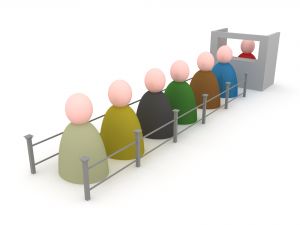I recently tested the virtual queue. I have been conquered by this mode of operation and I think it applies to many industries, particularly in the service sector. The omnipresence of the mobile in everyday life makes it a very effective tool to improve the quality perceived by customers and reduce waste!
What is virtual queue?
It is a service, offered to the customer, so that he has his waiting time freely, without losing his place in the queue.
Obviously, it is in the service industry that this option applies best. It benefits both the client and the provider, maintaining a high level of traffic and improving the mood of clients. In a context where the trend is instantaneous, waiting is less and less accepted. We are more impatient and irritability increases rapidly with the waiting time. We feel like wasting our time or even worse, that the company or service with which we do business is wasting our time. And especially since the service has a monopoly, as in the framework of public services.
Concrete example of using the virtual wait
I’m sick, but not to the point of no longer working, as my healing trailed a bit, I decided to go see a doctor. Without an appointment, I know I may have to wait a few hours in the waiting room. So I bring my computer to start processing e-mails. In Quebec, doctors are grouped in medical clinics. Walk-in patients are first assessed by a nurse. They are then seen by the doctor, according to the order of arrival (FIFO), but with a priority management. Some very serious cases, very contagious or particularly fragile people (babies) are prioritized.
If you have to wait about an hour to be assessed by the nurse, it can take three to six hours to see a doctor, depending on how busy the medical center is. After processing my emails, I start working on a document. I realize, that the laptop on the knees, stuck by my coat, without a mouse, is not the best set-up to be performant. In addition, there is agitation and discussion, which does not facilitate concentration.
It’s my turn to see the nurse. She offers me to register for the virtual waiting service. For $ 3.75, I will receive three alerts (messages on my cell phone) when there will remain 8, 5 and 3 patients in the queue before me.
Guesstimating cycle time to evaluate wait time
To better evaluate the time I have before coming back, I confirm with her the number of doctors. They are two this morning. I’m 36th in the queue, the 8th patient has just been called, but there are also urgent cases, so at least 30 people before me. If I have 10 minutes per patient, I have a minimum of 150 minutes …
I leave the clinic and settle down to continue my work, much more comfortable in my office. Two and a half hours later, I get the first alert: 8 patients before me. Which confirms me that the “treatment” time is more than 15 minutes, I still have time …
Less than a quarter hour later, there are only 5 patients left in the queue … I had forgotten the urgency patents in my calculation … So I go back to the medical center, where the doctor calls me fifteen minutes after my arrival.
The big advantage is that I was able to work, effectively, two hours, instead of “losing” my morning waiting. This is what Chronometriq promises to those who buy the service.

Do you have queues? Do you monopolize the time of your customers? How can you offer them a virtual wait service?

